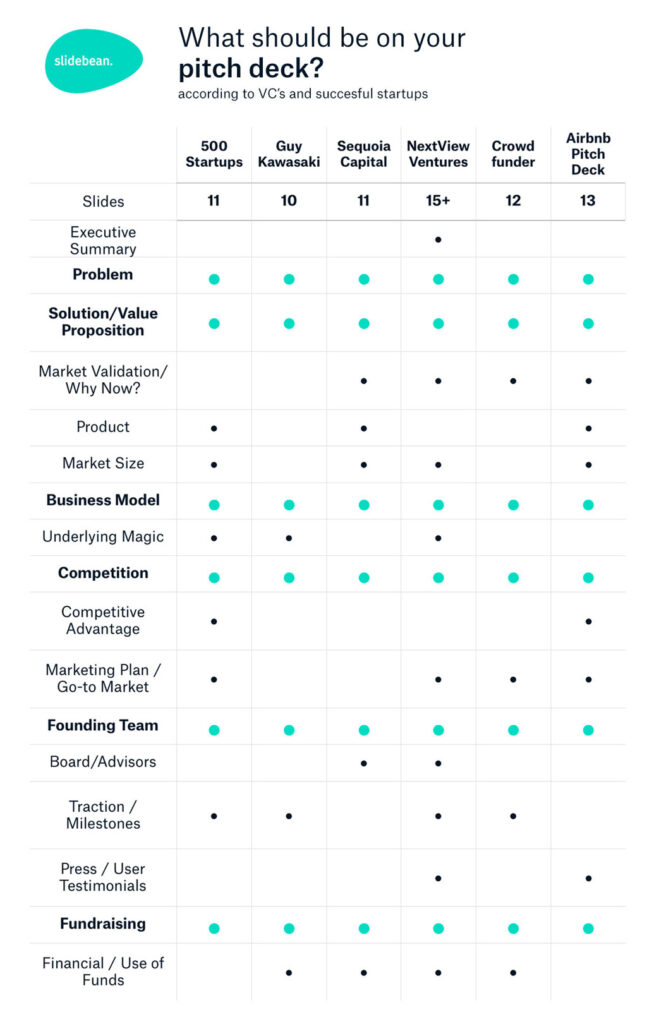Your deck is key to your pitch, so pitch deck structure is critical. A properly structured deck will enhance the investor’s journey – and a poorly structured deck will derail it.
Thanks to pioneers like Guy Kawasaki, we have a fairly standardized template of pitch deck structure:
- Title – Still can’t believe people would neglect to put a title in a pitch. But hey…
- Problem / opportunity – The pain you’re alleviating, the pleasure you want to provide.
- Value proposition – What’s the value of the pain you’re about to alleviate? What value will your idea bring to the world?
- Magic – What makes your solution special, and memorable?
- Business model – Who has your money in their pockets, and how are you going to get it into yours?
- Go-to-market plan – How will you reach your target with your message?
- Competitive analysis – The landscape of competitors, and what they’re great / not-so-great at.
- Management team – Who are your key players, what are their superpowers, and why are they indispensable?
- Financial projections and key metrics – Your 3 year forecast, with $, number of customers, conversions, etc.
- Traction / use of funds – What you’ve accomplished to this point / what funding will help you accomplish.
Things get interesting when you look at a pitch as a multipart exercise that involves several conversion / buy-in points:
- First, you need to capture the imagination of your audience,
- Then, you need them to follow along with your indepth story,
- Next, you need to reassure them that this story – and your idea – are worth investing in,
- And finally, you need to erase any lingering doubts.
Parsed this way, the initial pitch deck structure (that tells the story) is very different from the later investor deck structure (that reassures and erases lingering doubt).
How do you structure a pitch deck?
Slidebean / FounderHub CEO Caya created a very interesting chart comparing the components of a pitch deck (you can see his full blog post here). As you can see from the teal dots in his chart below, all the heavy hitters believe the following components should be in the deck:
- Problem
- Solution / value proposition
- Business model
- Competition
- Founding team
- Fundraising

With a bit of imagination, you can see that these components lend themselves quite nicely to classic three act play storytelling structure.
In a three act play, the protagonists, setting and problem are established in the first act. In the pitch deck diagram, you see the founding team and problem. However, you can’t properly describe a problem without describing the context it’s experienced in – aka the setting. And voila, we have protagonists, setting and problem.
Moving on to the second act, we see the protagonists in a pitched battle with the forces of evil, and things aren’t going well. In the deck, the villains are the competition.
In the third act, the protagonists discover a secret weapon, and use it to vanquish the villains and deliver a happy ending. The business model combined with the solution is the secret weapon. Fundraising covers the happy ending.
What order should a pitch deck be in?
We’ve established a great pitch deck has the same mission as a great story – to captivate and hold the audience. We’ve established that both have roughly the same ingredients. Now it comes down to the order.
Here’s where I would recommend you lean heavily on storytelling structure.
Imagine the first time you take the stage with your initial pitch. Your mission is to capture the imagination of your audience, and get the right investors to lean forward.
Your best weapon would be a great story.
With that in mind, it would be helpful to structure your stage presentation as a story. It will be easier to remember, easier to add drama to, and easier for your audience to relate to. As long as the requisite components are there, mission accomplished.
When you’ve left the stage, the most enthusiastic members of your audience are going to ask for a copy of your slides.
Again, you want to give them a story, not slides.
Imagine you could turn the terrific story you just told into a manuscript – complete with chapters and wonderful illustrations. This would be a refreshing departure from the photocopied slides most founders offer up.
What are the components of a pitch deck?
We’ve already covered the elements that should be included in a pitch deck. So let’s define components in a new light: what will make your pitch deck a great story?
- Every great story needs three things – characters, setting and conflict. Does your pitch deliver these?
- Every great story involves the audience. Does your pitch give the members of the audience a role to play in the success of the idea? Even if they can’t invest? Can the audience see themselves in your shoes? Will your experience motivate them to climb mountains of their own?
- Every great story teaches a lesson. Good will prevail. Stay in school. True love conquers all. Is there an easy-to-derive lesson or moral to your story?
- Every great story can be retold. Ask a test audience to retell your pitch after they hear it. The things they don’t remember don’t belong in your pitch. The things they do remember deserve to be emphasized.
What is the difference between a pitch deck and a presentation?
Pitch deck, presentation, investor pitch, investor deck – all these terms get bandied about and confused.
In my humble opinion, every moment in front of your audience is a presentation – whether it’s spoken or written.
That said, a live presentation enables you to build human resonance with your audience. The emphasis is on oral storytelling.
A written deck gives your audience a moment to digest information. The emphasis is on deepening the story.
An investor presentation is designed to give your audience the reassurance they need to pull out their pocketbook. Professionalism, absolute mastery over the details – especially business and financial details – is essential.
And an investor deck should be the guidebook of your reassuring presentation. All the facts and figures where they can be easily accessed, depth and detail without being wearisome.
Does your pitch deck capture the imagination? Does it get investors to lean forward in their chairs? Does it provoke the all-important ‘Tell Me More’ reaction? Book an Optimize My Pitch session with me to find out.
If you enjoyed this story, please pass it along to a colleague who can benefit from it.


